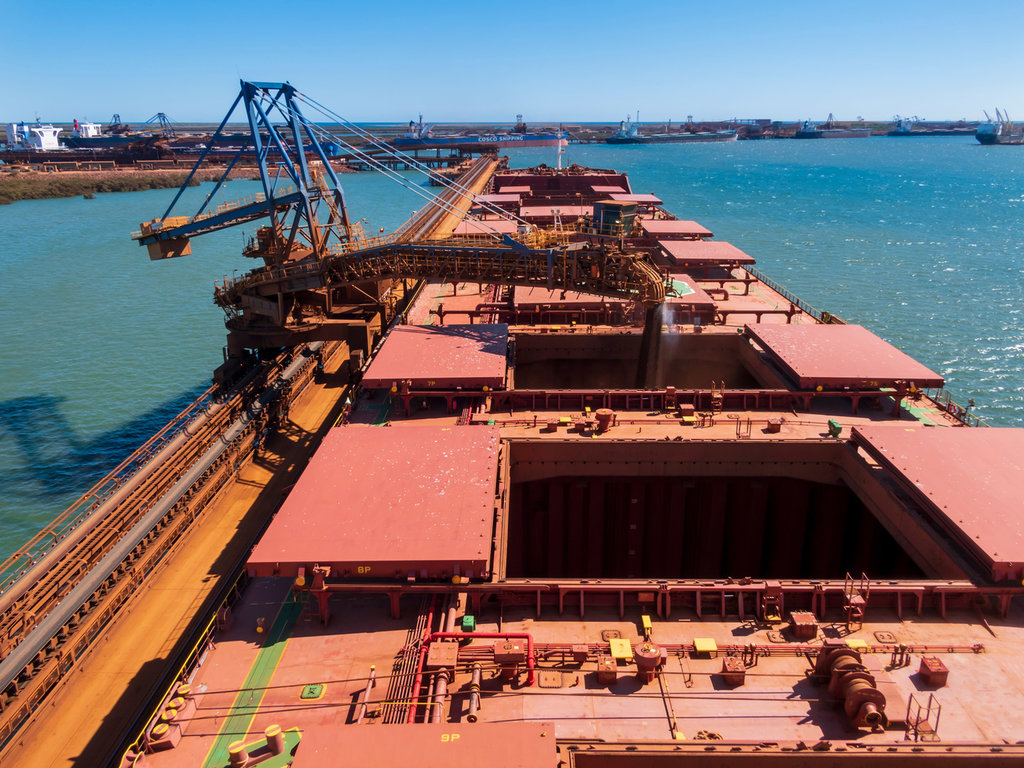Feature
Preparing Australia’s ports for growth and the green transition
Recipients of significant government investment, the Pilbara ports are preparing to be at the forefront of Australia’s green transition. Eve Thomas explores the next generation of Australia’s ports.

Dredgers and iron ore carriers operating at Port Hedland, Western Australia. Credit: Guscoan via Shutterstock.
Enshrined in law by the Climate Change Act in 2022, Australia will reduce its greenhouse gas (GHG) emissions by 43% from 2005 by 2030. This target has been supported by around A$40bn ($25.5bn) worth of government investment so far. In line with the Paris Agreement, Australia has also committed to reaching net zero emissions by 2050, but infrastructural limitations are proving problematic: Infrastructure Partnerships Australia’s 2022 investors poll found that 85% believed the Australian infrastructure market faces capacity constraints.
The modification of existing ports and development of new infrastructural projects has therefore become key for Australia’s Government, as it looks to prepare the country for a growing green industry. In West Australia, the Pilbara Ports Authority has received A$565m of investment specifically earmarked for the improvement of infrastructure, as authorities hope to see Australia become a global leader in the export of critical minerals essential to renewable technologies. These include lithium, cobalt, manganese and rare earth elements.
Australia is the global leader in lithium production, responsible for 53% of global production in 2021. It is also responsible for 11% of global manganese ore production, and 3% of cobalt production. These materials are used in batteries, which will be a crucial element of green transition as efficient storage becomes a priority for the renewable industry. Li-manganese batteries are particularly popular in the EV motor sector as, when blended with lithium nickel manganese cobalt oxide (NMC) they improve battery lifespan.
Considering the potential of the Pilbara region to participate in the growing green market, Samuel McSkimming, CEO of Pilbara Ports Authority, wrote in a recent report: “The energy transition will drive tremendous change in the Pilbara, and we are just at the start of the journey. We have partnered with government and industry to invest in port infrastructure to export the critical minerals that are vital for the energy transition, as well as enable the import of green energy infrastructure.”
The development of Lumsden Point
Located at Port Hedland, the development of Lumsden Point represents a significant element of the government’s investment, made in partnership with the Western Australian Government’s A$129.1m commitment. Once complete, Lumsden Point will be a multi-user facility and logistics hub, involved in metal exports and the import of solar panels, wind turbines and blades.
Explaining the development, McSkimming said: “The development will include construction of two new multi-user berths (a general cargo berth and a minerals export berth), a central access road and service corridor connecting to Great Northern Highway and dredging of an access channel and turning basins.”
As a whole, Port Hedland is already the world’s largest bulk export terminal, shipping 566 million tons in the 2022-23 financial year. While authorities have not given an estimate of how the new capacity would change the total tonnage shipped, it would effectively raise the number of available berths at the port by more than 10%.
According to the Pilbara Ports Authority 2022-23 report, Lumsden is expected to generate a 34-fold increase in full time jobs over the duration of the project, and it is expected to boost Australia’s gross domestic product by A$2.1 bn annually.
The next generation of Australian ports
Located nearby to mineral resources and with sunny and windy climates, Lumsden Point will represent a “critical piece of infrastructure essential to facilitating growth and trade diversification in the Pilbara. It will also ensure WA is prepared for the future as we transition to net-zero emissions,” according to Ports Minister David Michael.
As an industry, shipping has been slow to decarbonise. Doing so requires a new generation of efficient ships, and better port infrastructure to support them. Therefore, the development could enable cleaner shipping and remove carbon from the transport sector.
Expressing the government’s hopes for Lumsden Point, Michael said in July: “The ultimate development of Lumsden Point… is expected to save 3.6 million tonnes of emissions by 2055 by supporting direct shipping to the Pilbara and providing a pathway for renewable energy infrastructure.”

More than 90% of Port Hedland’s exports are iron ore. Credit: Ambient_Pix via Shutterstock.
On land, the wharf, laydown area and logistics hub at Lumsden Point will connect to the Great Northern Highway, streamlining trade and enabling private sector investment.
Lumsden Point is projected by Infrastructure West Australia to generate a net economic benefit of A$675.6m over a 35-year period. It will make a massive contribution to trade in the Pilbara, which saw 752.4 tonnes of commodities pass through the ports between 2022 and 2023.
Upgrading ports across the board
Pilbara Ports expects to improve its infrastructure across several ports, although not all developments would accelerate the move towards green industry. Over the next four years, the company plans to direct A$368.8 m of investment towards the expansion of general cargo infrastructure at the Port of Dampier, further west along the coast. The Port Hedland eastern harbour revetments are also in the process of being modified to improve resilience to extreme weather.
Port Ashburton has also recently benefitted from a selection of projects including in sand bypassing and biosecurity, as well as a new maintenance facility shed for oil spill response equipment.
In May, the federal government committed to creating an action plan to develop and decarbonise the country’s ports infrastructure, backing it with A$600,000. This is dwarfed by the A$1bn-over-four-years commitment that the government made to increasing biosecurity, in which ports will play a key part.
Mike Gallacher, Ports Australia CEO, said: “This is an exciting time for the Australian port industry, and we commend the federal government on their investment into the port sector. This is a prime example of how our ports are constantly evolving and growing to support Australia’s growing trade.”